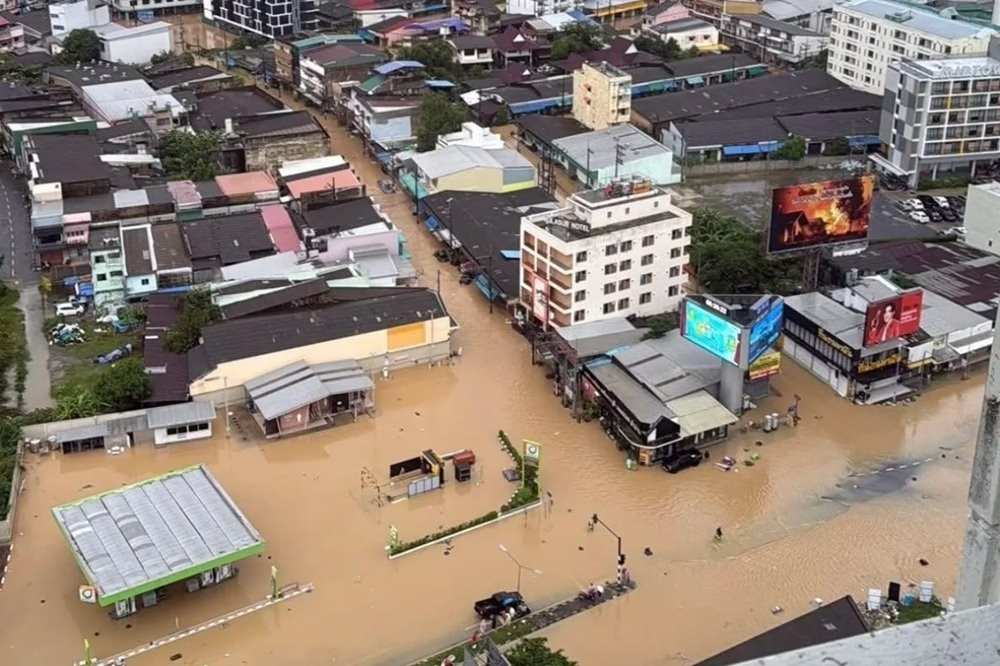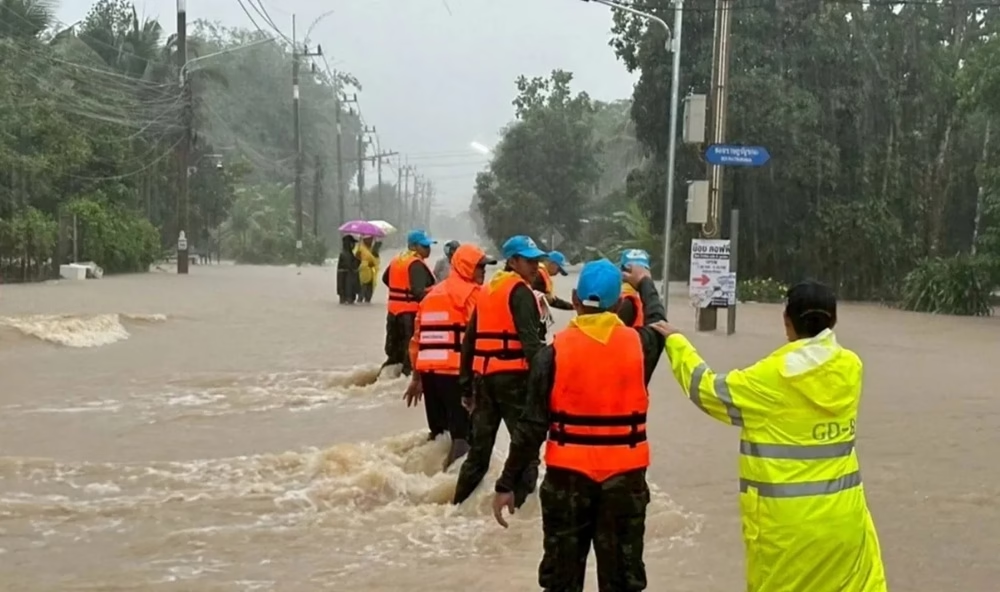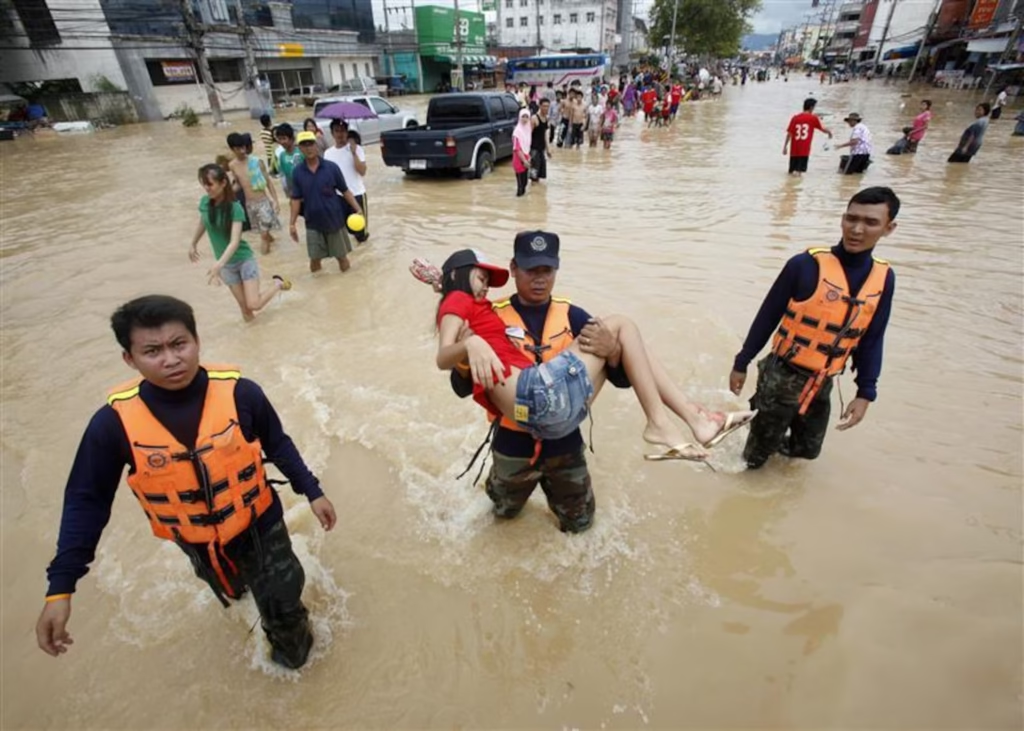HAT YAI – Relentless monsoon rain has thrown the busy city of Hat Yai in Songkhla province into crisis, with floods sweeping through streets, markets, homes, and hotels. What started as a normal rainy season has turned into a serious emergency, forcing officials to issue red-flag warnings and order evacuations in more than 100 communities.
With more downpours on the way, this city of around 200,000 people now faces a growing humanitarian emergency, where speed in getting help to those trapped or at risk is critical.
The situation worsened quickly after 19 November, when rainfall reached 595 millimetres over three days. This total has already passed the level recorded in the historic floods of 2000 (497 mm) and 2010 (516 mm), which still haunt many locals.
Canals such as Khlong Hwa swelled to 11.08 metres, sending huge volumes of water into smaller waterways.
Drainage systems buckled under the strain, and low-lying parts of the city turned into deep pools. By Saturday morning, water in the city centre stood at 40 to 60 centimetres, covering Phetkasem Road, Niphat Uthit, and the famous Kim Yong Market, a key trading spot for local sellers and Malaysian visitors.
Red-Flag Orders: Leave Now Or Risk Being Cut Off
At 8 a.m. on Saturday, Hat Yai Mayor Narongporn Na Phatthalung spoke over emergency broadcasts with a blunt message: “This is a red-flag alert. Move to higher ground immediately.” The order applied to 103 communities across the three municipal districts and affected many tens of thousands of residents.
On Friday night, authorities had already told people in 65 communities to move, but the rising water forced them to expand the evacuation zone. Mobile phone alerts were sent five times between Friday afternoon and Saturday morning, urging people to gather essentials and get out.
The alarm is driven by major water releases from the Rajamangala Dam, which have surged into the Khlong Rian and Khlong Sam Sip Met canals. Sudden flash floods hit with little warning, trapping families in their homes and blocking exits from crowded neighbourhoods.
“We woke up to water at our doorstep,” said Somchai Boonmee, a 52-year-old shopkeeper in the Sanehanusorn area, as he stood chest-deep in his flooded store. “The current is too strong for small boats, we are just hoping they bring pumps soon.”
Officials from the Department of Disaster Prevention and Mitigation say more than 1,800 villages across seven southern provinces, including Songkhla, Pattani, and Narathiwat, are now underwater, with Hat Yai among the hardest hit.
Large parts of the city have had power cut to reduce the risk of electrocution, and many areas have lost internet and piped water. The State Railway of Thailand has suspended 10 southern train services after tracks between Wat Khuan Mude and Chana stations were flooded. Five bus routes have also been halted, cutting off ground travel to the Malaysian border crossing at Sadao.
Human Cost Grows: Thousands Stranded And Anxiety Rising
Around 10,000 people in Hat Yai have had to leave their homes and move into temporary shelters set up at schools and temples. Hotels, which normally offer comfort and safety, have instead become islands for another 9,000 to 10,000 people, among them some 4,000 Malaysian tourists stuck in the city.
Sittipong Sitthiakkaraprapa, president of the Hat Yai-Songkhla Hotel Association, described a tense situation. “Guests are stretching what food is left, some families with babies are begging for milk and nappies,” he said.
On social media, pleas for help are spreading quickly. A Malaysian mother, Lily Suraini, posted a distressed video from Siam Oriental Hotel, where water in the lobby had risen to her knees as her young children clung to chairs. “We are trapped. No shops open, no way out,” she wrote, tagging Malaysian officials in the hope of a faster response.
The disaster has already claimed lives. By Saturday evening, at least two people in Hat Yai had been confirmed dead: an elderly man pulled away by strong floodwater in a narrow alley and a motorcyclist who drowned on the submerged Phetkasem Road. Across the wider southern region, the death toll has reached five, and rescue teams fear that more victims may appear as they search through strong currents and murky water.
Older people, those with illnesses, and poorer families in known flood zones have been hit hardest. “My grandmother cannot swim, we carried her out on a door,” said a crying resident from District 2, one of the first areas where 29 communities faced serious flooding.
Tourism, the main economic driver for Hat Yai, has been badly affected. The 43rd National Chamber of Commerce seminar, which brought 2,000 attendees to the city under the theme “Unlocking New Growth”, struggled through its first day before organisers cancelled the rest.
Popular hotels such as Buri Sriphu and Crystal reported flooded lobbies and had to move guests by boat. The Songkhla Chamber of Commerce warns that losses could reach 500 million baht (about 14.5 million dollars) if floodwater stays for one to two weeks, with effects ranging from mass hotel cancellations to closed restaurants during a key period for visitors from across the border.
Desperate Calls For Help: ‘We Need Boats And Supplies Now’
Rescue teams are working around the clock, operating pumps and using high-clearance trucks to move people to safety. Even so, requests for urgent support are rising. “We need boats for the inner canals, food for about 5,000 evacuees, medicine for people stuck in their homes, we cannot wait,” Mayor Na Phatthalung said during a crisis meeting.
The Red Cross and local charities are handing out emergency packs with rice, drinking water, and basic items, but flooded roads and damaged routes have slowed delivery. Malaysian Consul-General Ahmad Fahmi Ahmad Sarkawi has asked Malaysian citizens in Hat Yai to stay indoors and keep calm, and has provided a hotline number (+66 81 990 1930) for those who need help, as reports come in of more travellers stranded around the border area.
Thai AirAsia and Nok Air have both offered free changes for passengers flying to and from Hat Yai until 28 November. Airports of Thailand says Hat Yai International Airport is still open, with flights taking off and landing, although many passengers struggle to reach or leave the airport on time because of flooded roads and long queues for taxis.
State Response: Prime Minister Promises Strong Support
Prime Minister Anutin Charnvirakul arrived in Hat Yai on Saturday afternoon to see the disaster first-hand. Wearing rubber boots, he walked through waist-deep water on Road 1 and spoke with affected residents.
“The South is prepared, but the scale of this event needs everyone to act together,” he said, promising 100 million baht in immediate relief funds. Surrounded by military officers and local officials, he handed out survival bags and told staff at evacuation centres to keep supplies well stocked. “No one will be left behind,” he said, echoing earlier plans he had spoken about before the current floods.
Even as help arrives, some locals are doubtful. Previous floods exposed long-standing problems in drainage and city planning, and many wonder if this disaster is a sign of more extreme weather ahead. Engineers and planners are likely to face hard questions once the water has gone and the full damage is known.
Weather forecasts point to another 50 to 100 millimetres of rain by Monday, although water levels may start to drop if dam discharges ease and run-off clears. Across Hat Yai, neighbours share boats and makeshift rafts, and volunteers are helping older and disabled residents move to safety.
People are doing what they can with what they have, but their message is simple and urgent: fast, well-organised aid could prevent an even deeper tragedy. For now, Hat Yai waits, streets still underwater, watching the skies and hoping the worst has passed.
















